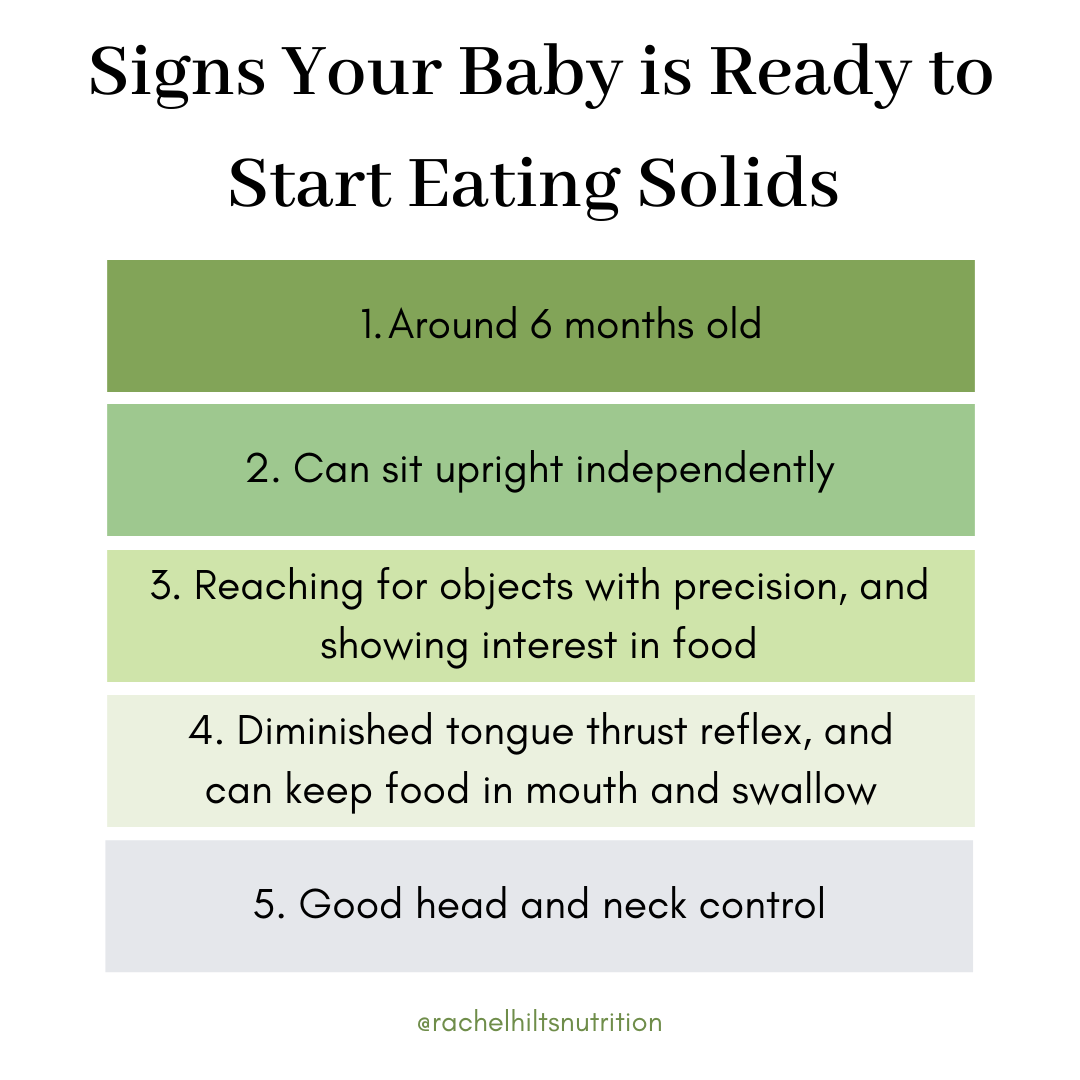When should I start feeding my baby solid foods?
Are you currently pregnant, or do you have a new baby and have started to wonder when you should be starting to transition them from breastmilk or formula to a diet that includes some solid foods (or purees)?
If so - this is the post for you! You may have been told that you should be feeding your baby exclusively breastmilk, formula, or a combination of the two (with some exceptions, like vitamin D drops) - but when do you stop feeding exclusively breastmilk and formula and switch instead to complimentary feeding that includes other types of food (in addition to continuing breastmilk/formula)? And how do you tell when your baby is ready for that step?
Read on for more info on the signs that your baby is ready to start complimentary foods.
Co-Written by Emily Stevens, Dietetics Student
Introducing solids is an important step in your baby’s nutrition that should typically begin around six months of age. After your baby reaches six months, it becomes challenging to meet all of their nutritional needs through breastmilk or formula alone, especially as the iron stores they had at birth are depleted (1,2,3,6).
Although breastmilk or formula should continue to be an important part of your baby’s nutrition beyond the six-month mark, this is where complementary feeding enters to help provide the proper nutrients and also the textures and skills needed to further your baby’s development and growth (2,3,6).
As with many developmental milestones, six months of age is solely a guideline. However, current evidence supports that six months of age is when infants are physiologically and developmentally ready for solid foods (1).
How do I know my baby is ready for solids?
Aside from reaching six months of age, there are a few developmental milestones we can consider when determining when you should introduce your baby to solid foods.
Keep in mind that showing only one or two of these signs, does not necessarily mean your baby is ready - the recommendations are to wait for all of these signs emerge and your baby is around six months old, as this is the age that starting solid food is safest for their digestive system and allergy prevention.
These signs of readiness will be the same, whether you decide to start your baby on purees or a baby-led-weaning approach.
Your baby can sit upright and has reasonable control of their head
If your baby can sit up with minimal support and show that they have reasonable control of their head movements, they may be ready to be introduced to solid foods (1,3,4,6). Your baby should be able to sit upright for the duration of a meal and hold their head steady on their own (6). Your baby should also be able to turn their head away to refuse food when it is offered and they are no longer hungry, demonstrating satiety (1,3,6).
Being able to sit upright on their own is potentially the most important sign to look for, as core strength is very important for developing the motor skills required for safe eating. Note that this means they can sit upright (at least for short periods) without the aid of a seating device.
Your baby opens their mouth when food is offered
If you hold out a spoon or food to your baby and they can open their mouth to accept the food (1,6). This stage also indicates that your baby may be showing more interest in your food and eating at meal times, which is another sign they may be ready for solid foods (5). You’ll likely see your baby grasping for toys, for your food at meals, or other objects, and trying to explore them with their mouth.
Your baby shows a diminished tongue thrust reflex
Your baby does not push spoons out of their mouth with their tongue, showing that they are transitioning from a sucking reflex to a swallowing reflex (5). This change in reflexes indicates that your baby will be able to swallow their solid food safely. They should be able to accept food into their mouth without you having to push it in.
Your baby can close their lips over a spoon or other food.
Your baby may not be perfect at keeping food in their mouth, but they should be able to close their lips at least partially over a spoon, keep food in their mouths, and swallow. Another sign is that when given food, your baby can pick it up with their hands and transfer the food to their mouth with little assistance, even if they make a bit of a mess (3,6).
If your baby meets the above criteria, is six months old, and has been showing an increased interest in what you are eating during family meals, they are likely ready to begin solids safely!
All babies will meet their developmental milestones at different paces. It is important that you use the above information as a guide and take individual advice from your health provider and dietitian on when your baby is ready to begin solid foods.
References
Manitoba Health. Feeding Your Baby: 6 months to 1 Year. [Internet]. Winnipeg Regional Health Authority; 2017. [Cited 2021 June 10] Available from: https://www.gov.mb.ca/healthychild/healthychild/healthybaby/hb_solidfoods.pdf
Health Canada. Nutrition for Healthy Term Infants: Recommendations from birth to six months [Internet] Health Canada; 2015. [Cited 2021 June 10] Available from: https://www.canada.ca/en/health-canada/services/canada-food-guide/resources/infant-feeding/nutrition-healthy-term-infants-recommendations-birth-six-months.html
HealthLink BC. Baby’s First Foods [Internet]. Child Nutrition Series (69); 2021 Apr. [Cited 2021 June 10] Available from: https://www.healthlinkbc.ca/hlbc/files/documents/healthfiles/hfile69c.pdf
Pope J, Romito K. Introducing Foods to Your Baby [Internet] University of Michigan; 2020 Dec. [Cited 2021 June 10] Available from: https://www.uofmhealth.org/health-library/te4473#te4473-sec
Critch, JN. Nutrition for Healthy Term Infants, six to 24 months: An overview. Paediatr Child Health 2014;19(10):547-49
Dietitians of Canada. Infant Nutrition - Complementary Feeding. In: Practice-based Evidence in Nutrition® [PEN]. 2019 Aug [Cited 2021 June 10]. Available from: Infant Nutrition - Complementary Feeding Summary of Recommendations and Evidence (pennutrition.com)
